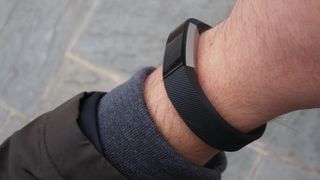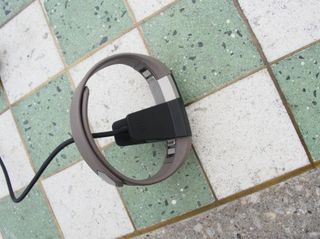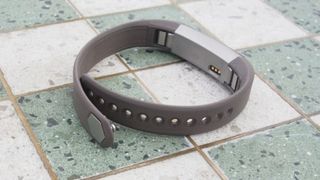Why you can trust TechRadar
Compared to Fitbit's other trackers, the Alta is easily the best-looking. It only gets better if you plop down the extra $59 (£40, AU$99) for swappable leather straps or $99 (£79) for the metal strap. But, let's look at the basics of what you'll be getting with the standard version.
Inside the box, you'll find the Alta module, as well as a set of "classic" elastomer bands to snap into it. Aside from the standard instruction booklets, there's also a USB dongle that can be used by those who would rather sync up to a desktop or laptop instead of a smartphone.

The module itself is simplistic, but elegant in its design. The plastic coating over the screen has the look and cool-to-the-touch feel of glass, and takes on a slight curve from end-to-end. It's hard to exactly tell how big the screen is beneath the sheet of black plastic, as there's only a little bit of info displayed at any given time.
The body of the tracker is wrapped in a brushed metal casing that gives it a nice amount of heft and visual flair. Laying on its side, you can see the angular effect come to an apex, and then diverge, creating a very subtle, but fantastic little stroke for a standard fitness tracker.
Flipped over, Fitbit's latest reveals its charging port. Unlike the Charge and Surge, which come with snap-in chargers, the Alta's cleverly clips on. It make fastening it a breeze by comparison, and it can be used a chip clip if you're really in a pinch. Jokes aside, I like it so much that I feel this should be Fitbit's de-facto charging method moving forward.

Fitbit built the Alta to be customizable, but to the extent that you explore those options is, obviously, up to you. But, let's say you do. You're going to need to take off the current band, and doing that is simple. On the bottom of the Alta, the band locks into the module with a snap-lock mechanism. Just push one side of the band at a time and slide it out. Replace it by pushing down until you hear an audible "snap."
Like the Alta, the Fitbit Blaze and Fitbit Flex both feature a removable module, and allows users to swap out bands to their liking. But, the company's latest fastens with a two-pronged mechanism, and not like many of the others in the lineup, which have straps that secure around your wrist like traditional watch.
Comfort
Fitbit's Alta is comfortable enough for all-day and all-night wearing, thanks to a few factors found in its design. First off, the module, like the screen, curves slightly. The side that touches your wrist is concave to fit the natural curvature around your wrist.

Next up, the latch mechanism is intuitive and hassle-free. The Charge HR and Surge fasten securely, but are a pain to loop through without devoting unnecessary coordination skills. The Alta is just as snug with two push pins on one side and a series of holes on the other to fasten them to. It's generally easier to put on, doesn't pinch arm hair and the fit is just right. I tried both large and small-sized bands and was able to find a comfortable zone in each.
The Alta retains its comfort no matter which bands you opt for. I'd go as far as saying that if you close your eyes and fasten the Alta around your wrist, you wouldn't be able to notice a difference between the rubbery-feeling Classic, the leathery Luxe, or the stainless steel bands. That speaks a lot to the Alta being a cozy wearable, but also that its optional bands are purely a cosmetic upgrade.

Fitbit provided the Alta for review with a large Classic band in black. It retains the etched styling found on the Charge and enjoys grabbing onto every dust particle in a one mile radius. This thing gets pretty mucky without much effort. Also in the goodie bag was the Graphite-colored leather option and it's a big improvement in terms of looks. But, the leather upgrade is just as comfortable as the Classic, and somehow, seems right at home on this Fitbit.
Current page: Design and comfort
Prev Page Introduction and display Next Page Specs, performance and interfaceCameron is a writer at The Verge, focused on reviews, deals coverage, and news. He wrote for magazines and websites such as The Verge, TechRadar, Practical Photoshop, Polygon, Eater and Al Bawaba.


